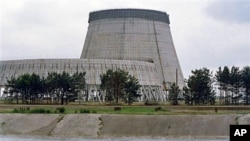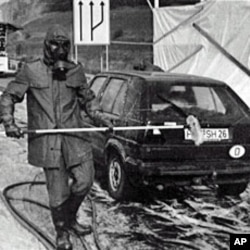Pripyat, Ukraine. A dead city. Homes, schoolrooms, playgrounds, and other places are crumbling as wild nature reclaims the land.
Pripyat once had some 50,000 residents. Now they are gone, perhaps forever. Only the artifacts of their lives remain behind, rotting to dust.
Pripyat died because of the deadliest nuclear power accident in world history. Chernobyl.
Early on April 26, 1986, reactor Unit Four at Chernobyl was put through an experimental test of its cooling system. The reactor overheated and exploded from steam pressure, ripping the roof off the power plant. Nuclear radiation spewed into the night sky. And, as people slept, it spread throughout Pripyat, just north of Chernobyl.
A nuclear accident with no end
In reactor four, the nuclear fuel and the graphite surrounding it were on fire. Authorities sent helicopters to fly over the reactor to dump sand and other materials to try to stop the fire. But, it burned for days.
The wind carried radioactive particles from the fire over a wide area. Ukraine, Belarus, Russia. Then, Scandanavia, Britain, and other parts of Europe. As the wind shifted direction, so did the radiation.
Finally, a day and a half after the explosion, an evacuation of Pripyat was ordered. People were told they would only be gone for several days, so they left nearly everything behind. They never returned.
Despite the wide spread of radiation, Soviet officials at first said very little publicly about what happened at Chernobyl. Many people believed their leaders rather than outside reports about the disaster.
"No. No. Everything is good. We do not tell lies on our radio and television," said a Russian woman.
It was radiation detectors in other countries, many hundreds of kilometers away, that forced the Soviets to admit to Chernobyl's accident.
Thousands of people were sent to Chernobyl to clean up debris from the blast. They also built a structure, called a sarcophagus, to cover the shattered reactor and its radioactive fuel. The workers' equipment became so contaminated that it had to be abandoned. The workers became contaminated as well. Many became ill.
The Soviet government said at least 31 fatalities at the Chernobyl plant were directly linked to the reactor explosion. The World Health Organization says another 22-hundred deaths can be expected among those who took part in the cleanup. The WHO report added that, in all, Chernobyl could result in 4,000 fatalities from cancer and other radiation-linked causes.
Radioactivity forced officials to create a 30-kilometer-wide no-habitation zone around Chernobyl, sealing off Pripyat. Still, the power plant continued to generate electricity until it was finally shut down in December, 2000.
The Chernobyl nuclear plant's Soviet RBMK [type design] reactors were not encased in thick concrete structures called containment vessels that are now standard in the industry. Philippe Jamet, the former Nuclear Installation Safety Director of the International Atomic Energy Agency, stresses their importance.
"The containment vessels are very, are one of the barriers. We have to protect the environment and people against radioactivity in case of an accident," said Jamet.
Russia, incidentally, still operates 11 RBMK-type reactors. The worst nuclear power accident in U.S. history, at Three Mile Island, Pennsylvania, on March 28, 1979, caused no fatalities and much lower impact to the surrounding area. A reactor containment vessel here remained intact despite a nuclear fuel partial meltdown.












